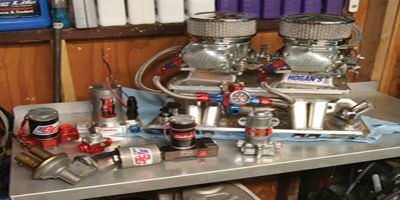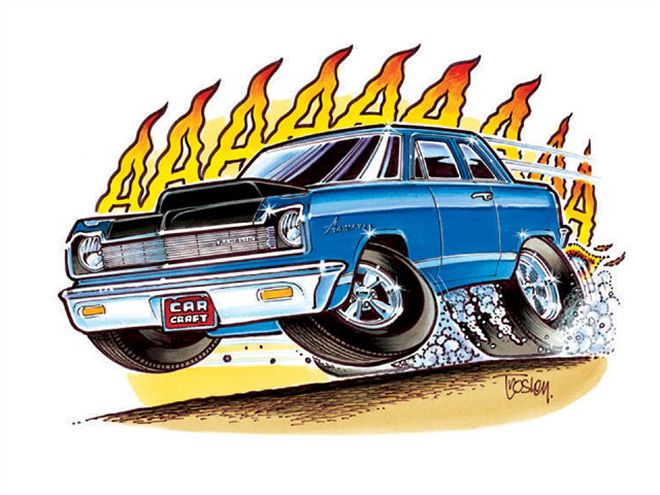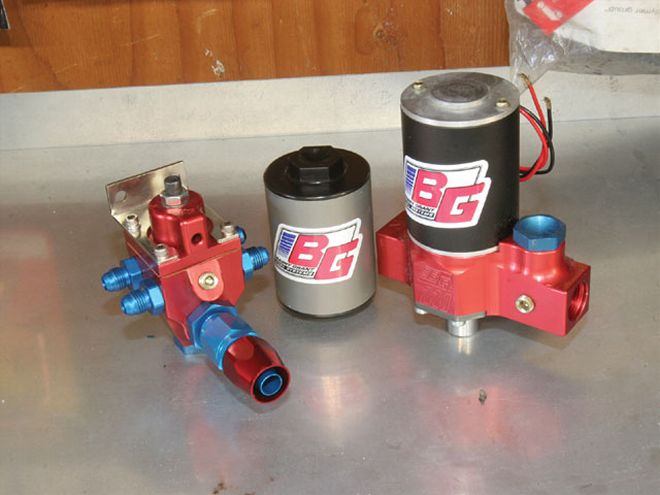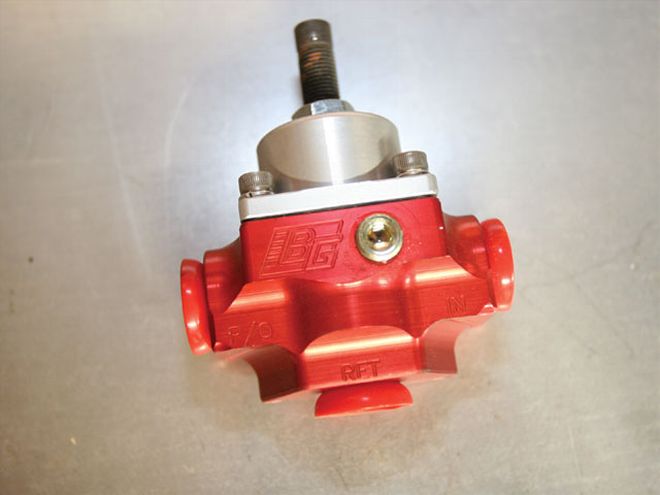
 CC/Rambler
CC/Rambler
If you have been following the CC/Rambler project, you might have noticed that we've made 480 hp and run 12.06 at 112 mph using a completely original fuel system. It has the crappy stock 31/48-inch pickup in the tank with original fuel lines and a Jeep Cherokee mechanical fuel pump. It works just fine, so we are going to fix it.
The next huge step for the car has always been nitrous oxide. We geared it high so we could add 1,000 rpm in the traps and bench-built the car with 150-, 250-, and 500-shots so we could visualize the schrapnel bouncing out of the 904 transmission. Good times. We also have a gnarly Tim Hogan intake manifold that we've been trying to install on the car in between differential explosions, paint jobs, transmission deaths, and drinking beer on the couch on Sundays instead of working on the car.
Before we can plumb in the happy gas and the corresponding timers and such, we have to rig up a fuel system that will both feed the existing engine and be upgradable as we put more power to the ground. The fuel systems we are going to address in this article are for carbureted cars, because that's what we think most of you guys are using. We are also going to talk a little theory so you can apply what we've discovered here to your street machine. Check it.
Fuel PumpsThe very first thing you are going to need to know is how fast you want to go. If you don't care about going fast, you need to know how much horsepower you're making or want to make. If you don't have access to an engine dyno, you can rely on Desktop Dyno from Comp Cams or a similar program to get into the ballpark. We have, and it works.
The 370-inch V-8 in the Rambler makes 480 hp at 6,000 rpm, so we can fit that number into a handy formula, 2 (flywheel hp x brake-specific fuel consumption (BSFC) / 6) = gph, to calculate the needs of the engine in gallons per hour (gph). This formula is an industry standard that takes into consideration g-loads and friction losses in the lines.
What is BSFC? A gasoline-powered, naturally aspirated engine uses roughly 0.5 pounds of fuel to make 1 hp for 1 hour at WOT. The calculation is
BSFC = fuel lb/hr uncorrected brake hpObviously you are going to need an engine dyno with a fuel-flow meter to get both parts of the equation, or you can guess using a rule of thumb developed from thousands and thousands of previous dyno runs. For the purpose of selecting a fuel pump, the BSFC range varies from 0.38 for an extremely efficient racing engine with great cylinder heads to 0.65 for an engine with a turbo or blower. If you take the average of these two numbers, you get 0.515, which is why everyone uses 0.5 for this calculation when a dyno sheet isn't available.
We used the formula and ended up with 80 gph as the requirement for a fuel pump: 2 (480 flywheel hp x 0.5 BSFC / 6) = 80. We checked the lineup of mechanical fuel pumps from sources like Holley and found that the pump with an advertised rating of 80 gph actually flowed slightly less than 40 gph at 6,000 rpm and 4.5 psi. This is because the advertised number is based on zero-pressure free flow and, as Sesame Street taught us years ago, as pressure increases, flow decreases. Considering that a high-performance engine with a carburetor requires 6-8 psi, this is clearly not enough pump. Instead, we looked to Holley part number 12-327-13. That pump is rated at 130 gph free flow and pumps 85 gph at 4.5 psi and 6,000 rpm. We know this because these pumps are accompanied by a flow chart in the Holley catalog. Using the chart, you can see how much fuel the pump is actually capable of pumping at a certain pressure and rpm.
 These are the main components of the BG dead-head-style system with afour-port regulator for a tunnel-ram and a fuel filter with areplaceable element that attaches to the inlet side of a fuel pump. BGoffers at least three different complete systems that include everythingyou need to feed over 650 hp.
These are the main components of the BG dead-head-style system with afour-port regulator for a tunnel-ram and a fuel filter with areplaceable element that attaches to the inlet side of a fuel pump. BGoffers at least three different complete systems that include everythingyou need to feed over 650 hp.
Mechanical Or Electric?That raises the next question. Should you use a mechanical pump or an electric one? This is a money issue first and a car-design issue second. If you are making the kind of power we are, the mechanical pump is the less expensive option. The pump mentioned earlier retails for $85.95 and, according to the math, can feed right around 500 hp. The inlet and outlet are also tapped for 31/48-inch line, so you can use your stock fuel system (unless your car is equipped with 51/416-inch stuff; then you should upgrade that anyway). There are mechanical pumps out there that will pump up to 225 gph and feed 675 hp, but you will need to buy a regulator and some AN fittings and lines, so be sure to factor those into the total cost.
There is also driver preference. Circle track guys like it when the mechanical fuel pump quits when the engine dies so that if they flip the car, the pump isn't glugging fuel all over the hot parts while they are headfirst in the clay. Street machine guys usually like to hear that pump whirring away and see the filter or the pump itself mounted next to the fuel cell. It's cool. Drag racers like to know that when the engine is on, the fuel pump is at maximum pressure and ready to go on a hard launch. Electric-pumps start at maximum pressure and flow, and flow drops as pressure increases. Mechanical pumps start at low flow and increase with rpm. Because of that, the mechanical pump uses and delivers fuel based on demand.
In our case we are going to be pumping up the horsepower to 550 or so, feeding a tunnel-ram, and eventually running a parallel nitrous system. The stock fuel tank hits the differential and leaks, so we are going to either install a fuel cell or get a replacement tank and add a sump. All of this leads us to a trunk-mounted electric pump for easy access and track maintenance. We also like the mechanical noise and the glamor.
Return or dead head?The term "dead head" simply means that the fuel in the system does not recirculate back to the gas tank from the front of the car. A return system recycles fuel back to the tank using either a bypass at the fuel pump or at the regulator.
Engines with mechanical pumps can use dead-head systems because fuel pressure only increases with rpm and the design of the pump only allows as much fuel into the pressure side of the system as is needed by the carburetor. Although there are some factory musclecar-era machines that use a return system, most do not for this reason. We ran a mechanical pump with no return line for two years and, even though we drove it to Vegas in scorching heat, never had a fuel-related problem.
When you add an electric pump to a dead-head system, fuel is constantly working against the pressure regulator or being bypassed within the fuel pump itself, causing extra heat and sometimes air to be forced into the system. The more of each you add, the closer you get to the point where the fuel becomes so hot that it turns to vapor and stops being delivered to the engine. On a car that sees the street and long road trips, the result is trouble. This situation also causes a pressure drop, as the needle and seat open to fill the bowls of the carburetor, and constant starting and stopping of fuel flow. These problems are why factory fuel-injected cars with electric pumps always use a return system.
A typical Barry Grant (BG) return system works by pumping fuel pressure to the regulator mounted downstream of the carb. Since the regulator will be set to provide 6-8 psi, the unused fuel will be sent back to the gas tank or fuel cell. This ensures that the fuel is constantly flowing and that fresh, cool fuel is always available at the carburetor. Another advantage to the return system is that the fuel pressure is the same throughout the system, eliminating pressure drops between the regulator and the carbs and ensuring that fuel-pressure settings remain constant under load.
 This is a return-style regulator. The fuel enters from the right througha -8 AN line and exits on the left. If you set the regulator for 8pounds, additional fuel would constantly be flowing through the lowerport and back to the fuel tank.
This is a return-style regulator. The fuel enters from the right througha -8 AN line and exits on the left. If you set the regulator for 8pounds, additional fuel would constantly be flowing through the lowerport and back to the fuel tank.
If you are stubborn and want a dead-head-style system or are clicking off 1.20 60-foot times in a trailered race car, BG offers the BG400 pump, which has an externally adjustable bypass right at the pump that can return fuel to a rear-mounted fuel cell or tank. It's really not designed for street use, but for burger-stand guys and short trips, there is a power stepdown box that will cut the voltage to the pump so it will not overheat. A toggle switch is used to put it into street driving mode, then a throttle switch takes the system back to full voltage at WOT. Pretty neat.
If you still insist on trying a dead-head system, there is the Enduro series from BG, which allows you to run a big electric pump on the street. The trick is an internal bypass and a fuel-cooled gerotor-style motor. The King, Mighty, and Speed Enduro pumps can feed 2,000-, 750-, and 500hp engines respectively and can also be hooked to an additional aluminum heat sink if necessary for additional abuse.
RegulatorsAt the very low end of the fuel pump spectrum you can find fuel pumps that don't require a pressure regulator of any kind. They are the mechanical pumps that provide less than 110 gph free flow and don't build pressure much higher than about 8 psi, and electric pumps that provide less than 100 gph free flow and don't build pressure above 7 psi. If you need more pump, you need a regulator.
Using Holley carburetors as an example, the needle-and-seat assembly can control fuel flow up to about 8 psi. Any more than that and unregulated fuel will flood the bowl, enter the carb through the venturi as it pours out of the vent tubes, and stall the car at idle or create a huge rich condition at full throttle. The regulator simply uses spring pressure to regulate fuel pressure. There is a screw or Allen bolt on top of the regulator that when turned clockwise adds preload to the spring, increasing the amount of pressure required to unseat the regulator. A dead-head-style regulator simply stops fuel from flowing when the valve is closed. A return-style regulator allows fuel to flow back into the tank. There are several sizes available, but the basic breakdown is for either 31/48-inch or 11/42-inch fuel line. There are also four-port regulator dead heads for tunnel-rams and single-return styles for multiple carbureted street machines.
When using return-style regulators, it's important that the return line is within one size of the feed line. If the line is too small, fuel will not be able to return to the tank fast enough and you will not be able to lower the fuel pressure at the feed line no matter how many times you turn the screw.
Since every pressure regulator has fuel pressure versus spring pressure vented to atmosphere, you can run a fitting to manifold pressure. On boost, the extra atmosphere will increase fuel pressure at a 1:1 ratio. Nitrous guys should have a separate fuel system for safety reasons. If the main fuel system fails at full throttle, the nitrous will still be spraying. With a separate line you can run a safety switch that kills the nitrous when fuel pressure drops below a predetermined limit.
Fuel LinesWe've been having a small debate about the size of the feed line from the fuel tank or cell. BG recommends a -12 (31/44-inch) line for the BG-400 and even sent us a photo of a cavitated pump as proof that bigger is better. The theory is that since electric pumps are designed to push and not pull, they need all the help they can get. Yet most fuel cells come with a -8 (11/42-inch) line, and the guys at Holley saw no problem with a -8 feed. What BG and Holley agree on is that the primary line should be -8 (11/42 inch) from the pump to the regulator and at least -6 (31/48 inch) on the way back.
If you are using a factory gas tank, the return line should be as far away from the pickup as possible to prevent the returning fuel from frothing and disturbing suction. All that fuel going to the pump has to be replaced with air in the tank, so it needs a suitably sized vent with some kind of filter attached or fuel will stop flowing.
WiringThis is easy. You'll need to run a minimum 12-gauge or preferably 10-gauge wire from a battery source to the fuel pump using a relay, and then switch the relay on and off using a 12-volt source from the ignition key or, in some cases, a toggle switch. Since fuel pumps are simply electric motors, the amount of current supplied can affect the speed, and therefore the efficiency, of the pump. Ever had a low battery or a bad connection and had your starter spin really slowly, barely turning over the engine? Same thing. The minimum voltage you should deliver to the pump is 13.2 volts, but companies like Mallory advertise the maximum pump gph rating at 14 volts, so the closer you can get to the ideal between 13.5 and 14.2 volts, the better.
Just as the power wire is important, the ground wire needs to also be 12 gauge or larger and attached to a clean portion of the frame near the pump. If the pump is straining or getting hot, check the ground circuit first.
PARTS LIST DESCRIPTION PN SOURCE PRICE Autogage fuel-pressure gauge ATM-2180 {{{Summit}}} Racing $31.95 BG 220HR fuel pump 170013 Jegs High Performance 249.99 BG King Enduro fuel pump 170044 Jegs High Performance 515.99 BG diaphragm bypass 171021 Jegs High Performance 69.99 BG fuel-cell-to-pump kit 152387 Jegs High Performance 141.99 BG pump-bypass to return-line kit 150187 Jegs High Performance 66.99 BG fuel-pump-to-regulator kit 150287 Jegs High Performance 195.99 BG regulator-to-dual-carb kit 151587-6 Jegs High Performance 183.09 BG regulator-to single-carb kit 151687-6 Jegs High Performance 94.50 Competition Engineering fuel-tank sump kit C4040 Summit Racing 61.88 Mighty Demon TR 650 carbs, each 5282010GC Jegs High Performance 549.99 Edelbrock mechanical fuel pump 1721 Summit Racing 85.88 Edelbrock electric fuel pump 1791 Summit Racing 145.88 Hogan's Racing Manifolds tunnel-ram N/A Hogan's Racing Call Holley HP125 fuel pump 12-125 Summit Racing 179.95 Weiand tunnel-ram linkage kit WND-4032 Summit Racing 165.95 Summit Racing aluminum fuel cell 291220-SC Summit Racing 314.95